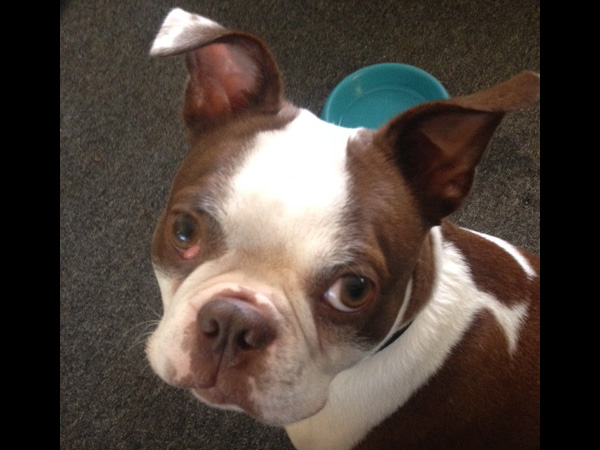This is Roscoe. He is a an 18 month old Boston Terrier who is currently being fostered in Ottawa, ON. While in our foster care, Roscoe will be having surgery to repair his cherry eye. We expect his total vetting to be in the approximate range of $2500.00.
The condition commonly called “cherry eye” occurs when a tear gland protrudes from your dog’s eye socket. Easily spotted, it appears as a pink or red mass bulging from the corner of the eye nearest your dog’s nose. It can affect either one or both eyes AND can be recurrent.
Located underneath the nictitating membrane (known as the third eyelid) which protects a dog’s eye from wind, dust and debris, this tear gland provides the cornea with essential lubrication. Once this gland has slipped or prolapsed, your dog’s eye loses most or all of its vital moisture, often resulting in keratocon junctivitis sicca or dry eye, which, if left untreated, can ultimately lead to blindness.

Although “cherry eye” is commonly associated with a congenital weakness of the gland’s attachment in the dog’s eye, it isn’t known if the condition is inherited. And while this condition can affect any breed of dog, it’s more common in Cocker Spaniels, Bulldogs, Beagles, Bloodhounds, Boston Terriers, Lhasa Apsos and Shih Tzu.
As a conscientious dog owner, then, pay attention to: any watery or thick discharge from your dog’s eye; a red or pink blob in the corner of his eye; redness in the lining of one of his eyelids, or persistent pawing at his eye.
If you witness any of the above, allow your vet to examine your dog’s third eyelid to determine precisely what the problem is. The diagnosis can even include scrolled or everted cartilage in the third eyelid, abnormal cells in the third eye, and a prolapse of fat in his eye.
With no preventative measures for “cherry eye” at this time, treatment is the only option. In milder cases, topical anti-inflammatory drugs will usually be prescribed, which are highly effective in reducing the swelling. Keeping your dog’s eyes well lubricated by using the highest quality eye drops may also help prevent a recurrence of the condition.
If corrective surgery is suggested, the tear gland can either be stitched back into place (this procedure is not 100% effective and a prolapse may reoccur) or the third eyelid removed completely, necessitating the use of eye drops every day from then on.
With more research needed into the causes, prevention and treatment of “cherry eye,” all caring dog owners can do is keep a watchful “eye” on their cherished canine companions and keep them safe.


